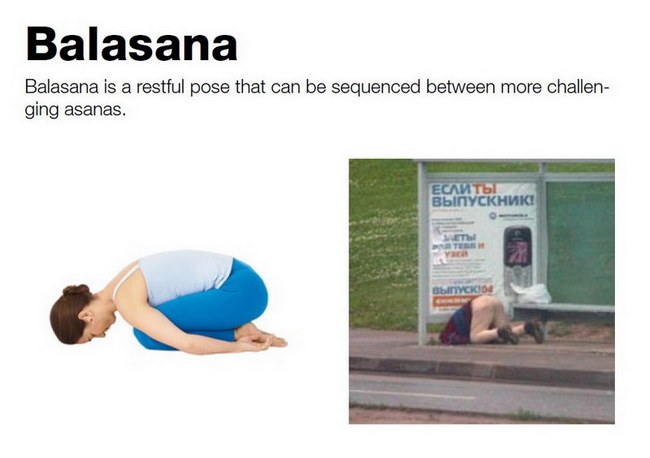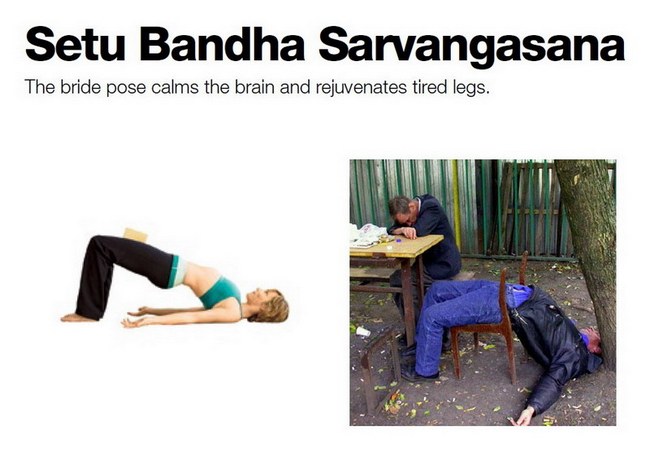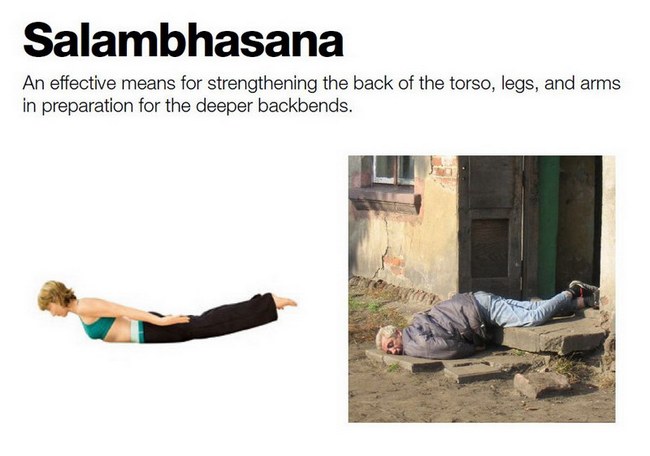Yoga as it is

All you and I have heard this word – “yoga”, which most people associate with different physical activity, standing (or seats) in certain difficult postures (such as lotus posture) in yoga postures are called “asanas”. Physical training yoga becomes more popular in Europe and America in the general population and occupies a place of honor next to the gym, gymnastics, bodybuilding and other physical culture disciplines.
People who practice yoga are called yogi. Many also think that yogi are such gentlemens that are sleeping naked on a bed of nails, breathe fire and they do all sorts of similar things. Of course this is all wrong, no reputable yogi will never suffer such garbage as sleeping on nails, and those who do, in India they are called fakirs. (Fakir yogi not a friend)
And our physical training yoga has nothing to do with the fact that this is yoga, which originated in distant India many thousands years ago.
The word yoga has multiple meanings and translations from Sanskrit, here are some of them: the exercise, communication, unity, harmony, union. From these words, the content is most appropriate exercise, that is, yoga is an exercise. Do not just exercise, but a whole complex of psychospiritual exercises, which leads to harmony with the world, eternal happiness, enlightenment. And as to achieve all this, not just enough, then the Yoga path is not simple. Since people are different and that people have different ways, so there are many different types of yoga. Athletes Yoga, which is widely practiced in modern world, officially called “hatha yoga”. Except it where is still karma yoga (yoga of activity), bhakti yoga (yoga of service), Jnana Yoga (yoga of knowledge), raja yoga (yoga of power). These are the main types of yoga, but apart from them there are also fitness yoga, yogaterapiya, yoga for pregnant women, corporate yoga, yoga for beginners, cowboy yoga.
The first mention about yoga, we see already in very ancient times. Rock slabs found by archaeologists in the Indus Valley depicting people in meditation and yoga poses. These plates are dated 3300-1700 BC. BC The first written mention of yoga can be found in the most ancient religious writings of the world – Indian Vedas. Namely, in the Rig Veda – a collection of Indian hymns. Also on Yoga in the Upanishads says one, the sacred Indian epic Mahabharata, and the main part of Bhagavadgite. The most fundamental work on yoga was in Hinduism, they are the “Yoga Sutras” made by the Indian sage Patanjali in the 2nd century BC. Also, “Yoga Sutras” is often called the “Sutra of Patanjali”, and Patanjali is considered the founder of the Yoga, as a philosophical and religious school, though nothing new Patanjali did not open, but simply collected and systematized knowledge of yoga from the more ancient Indian scriptures.
In the very Sutras of Patanjali it is mainly about raja yoga (its other name – royal yoga). In fact, raja yoga this is the real classical Indian yoga, yoga as it is. Raja of the Indian master, lord, king, and the meaning and the main goal of Raja Yoga – be your own boss. (And who knows how to govern themselves, can control the other) that is raja yoga – a set of exercises that lead to the ability of man to control himself, his emotions and thoughts. This occurs through concentration of mind and meditation classes. In fact, meditation and Raja Yoga are the same, and the main tools of Raja Yoga is Dhyan and a Dharana (meditation and concentration).
Karma Yoga (yoga of activity) is also one of the main yogic trends, its meaning is to perform good deeds without attachment to the fruits of their labor. In the Bible, this is referred to in the phrase of the Gospel, “Let your left hand not know what the right hand did”
Bhakti Yoga (yoga of service) is aimed at establishing a personal relationship with God through service to Him with love and devotion. Christian Baptists (and Charismatics) singing religious songs, spirituals, and calling for the establishment of a personal relationship with Jesus – in fact, most real Christian practice of bhakti yoga.
Jnana Yoga (yoga of knowledge) is an intelligent search of wisdom, when one tries to understand the thinking through the true nature of himself.
Finally, Hatha yoga – yoga of athletes, the direction of systematic yoga yogic sage Swami Svatmaramoyu in his treatise “Hatha Yoga Pradipika” written in the 15th century AD (not so long ago). The main objective of hatha yoga – achieving physical harmony and health through physical exercise, sitting in asanas, diet, etc. In “Hatha Yoga Pradipika” describes about 80 different yoga postures (asanas), which seemed the god Shiva gave, so that while they still could improve body and spirit. That Hatha Yoga, which is taught in our yoga and fitness centers, it is not even that yoga, which is described in the “Hatha Yoga Pradipika.” The founder of modern hatha yoga was a Hindu – Krishnamacharya, who was bored to sit motionless in the asanas, and to warm up, he decided to use the asanas in dynamic, changing his position. So yoga-charging appeared – the modern hatha yoga. In our time, hatha yoga from the spiritual exercises become commonplace fitness, or just exercise, and observations show 90% of people that practice yoga, do not know what yoga is.
And in the end a little bit of humor, as it turned out do hatha yoga not only people who care about their health.







